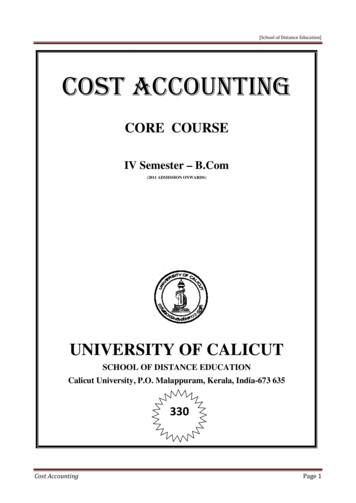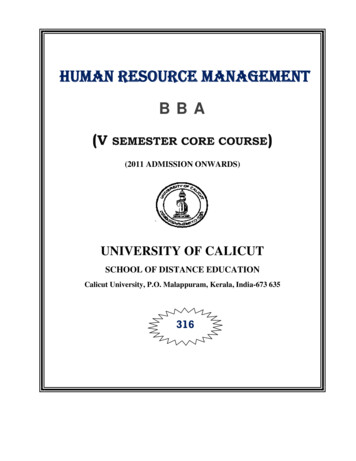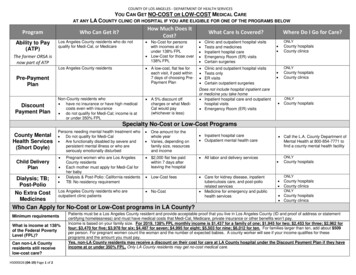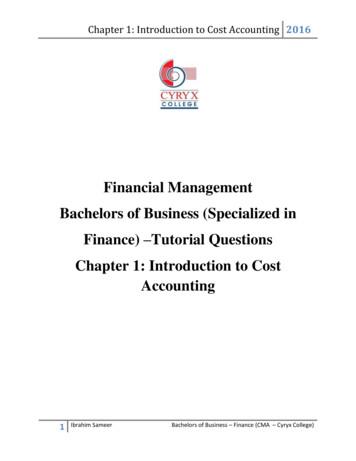
Transcription
[School of Distance Education]COST ACCOUNTINGCORE COURSEIV Semester – B.Com(2011 ADMISSION ONWARDS)UNIVERSITY OF CALICUTSCHOOL OF DISTANCE EDUCATIONCalicut University, P.O. Malappuram, Kerala, India-673 635330Cost AccountingPage 1
[School of Distance Education]UNIVERSITY OF CALICUTSCHOOL OF DISTANCE EDUCATIONCOST ACCOUNTINGIV SEMESTERCORE COURSE - B.Com.Prepared by:1. Sri. Vinesh Ottuparammal,Assistant Professor,Govt. College, Malappuram2. Smt. T. Shameera Kunhu. T,Assistant Professor,Govt. College, Malappuram3. Sri.T.H. Jahfarali,Assistant Professor,Govt. College, Malappuram.Scrutinised by:Dr. K. Venugopalan,Associate Professor,Dept. of Commerce,Govt. College, Madappally.Layout & Settings: Computer Section SDE ReservedCost AccountingPage 2
[School of Distance Education]CONTENTCost AccountingPAGEModule I5Module II19Module III34Module IV60Module V98Page 3
[School of Distance Education]Cost AccountingPage 4
Module I[School of Distance Education]IntroductionCost Accounting is a branch of accounting and has been developed due to limitations of financialaccounting. Financial accounting is primarily concerned with record keeping directed towards thepreparation of Profit and Loss Account and Balance Sheet. It provides information regarding theprofit and loss that the business enterprise is making and also its financial position on a particulardate. The financial accounting reports help the management to control in a general way the variousfunctions of the business but it fails to give detailed reports on the efficiency of various divisions.The limitations of Financial Accounting which led to the development of cost accounting are asfollows.Limitations of Financial Accounting1. No clear idea of operating efficiency: Sometimes profits in an organization may be less ormore because of inflation or trade depression and not due to efficiency or inefficiency. Butfinancial accounting does not give a clear reason for profit or loss.2. Weakness not spotted out by collective results: Financial Accounting shows the net resultof an organization. When the profit and loss account of an organization, shows less profit or aloss, it does not give the reason for it or it does not show where the weakness lies.3. Does not help in fixing the price: In Financial Accounting, we get the total cost ofproduction but it does not aid in determining prices of the products, services, production orderand lines of products.4. No classification of expenses and accounts: In Financial Accounting, we don’t get datarelating to costs incurred by departments, processes separately or per unit cost of productlines, or cost incurred in various sales territories. Further expenses are not classified as director indirect, controllable and uncontrollable overheads and the value added in each process isnot reported.5. No data for comparison and decision making: It does not supply useful data tomanagement for comparison with previous period and for taking various financial decisionsas introduction of new products, replacement of labour by machines, price in normal orspecial circumstances, producing a part in the factory or buying it from outside market,production of a product to be continued or given up, priority accorded to different products,investment to be made in new products or not etc.6. No control on cost: Financial Accounting does not help to control materials, supplies,wages, labour and overhead costs.7. Does not provide standards to assess the performance: Financial Accounting does not helpin developing standards to assess the performance of various persons ordepartments. It alsodoes not help in checking that costs do not exceed a reasonable limit for a given quantum ofwork of the requisite quality.8. Provides only historical information: Financial Accounting records only the historicalcosts incurred. It does not provide day-to-day cost information to the management formaking effective plans for the future.Cost AccountingPage 5
[School of Distance Education]9. No analysis of losses: It does not provide complete analysis of losses due to defectivematerial, idle time, idle plant and equipment etc. In other words, no distinction is madebetween avoidable and unavoidable wastage.10. Inadequate information for reports: It does not provide adequate information for reportsto outside agencies such as banks, government, insurance companies and trade associations.11. No answer for certain questions: Financial Accounting will not help to answer questionslike:(a) Should an attempt be made to sell more products or is the factory operating to capacity?(b) if an order or contract is accepted, is the price obtainable sufficient to show a profit?(c) if the manufacture or sale of product A were discontinued and efforts make to increasethe sale of B, what would be the effect on the net profit? (d) Why the profit of last year isof such a small amount despite the fact that output was increased substantially? Etc.Costing and Cost AccountingThe costing terminology of C.I.M.A ., London defines costing as the “the techniques andprocesses of ascertaining costs”. These techniques consist of principles and rules which govern theprocedure of ascertaining cost of products or services. The techniques to be followed for theanalysis of expenses and the processes by which such an analysis should be related to differentproducts or services differ from industry to industry. These techniques are also dynamic and theychange with time.The main object of traditional cost accounts is the analysis of financial records, so as tosubdivide expenditure and to allocate it carefully to selected cost centers, and hence to build up atotal cost for the departments, processes or jobs or contracts of the undertaking. The extent to whichthe analysis of expenditure should be carried will depend upon the nature of business and degree ofaccuracy desired. The other important objective of costing are cost control and cost reduction.Cost Accounting may be regarded as “a specialized branch of accounting which involvesclassification, accumulation, assignment and control of costs.” The costing terminology of C.I.M.A,London defines cost accounting as “the process of accounting for costs from the point at whichexpenditure is incurred or committed to the establishment of its ultimate relationship with costcenters and cost units. In its widest usage, it embraces the preparation of statistical data, theapplication of cost control methods and the ascertainment of profitability of activities carried out orplanned”.Wheldon defines cost accounting as “classifying, recording and appropriate allocation ofexpenditure for determination of costs of products or services and for the presentation of suitablyarranged data purposes of control and guidance of management”. It is thus a formal mechanism bymeans of which costs of products or services are ascertained and controlled.General Principles of Cost AccountingThe following may be considered as the General Principles of Cost Accounting:1. A cost should be related to its causes: Cost should be related as closely as possible to theircauses so that cost will be shared only among the cost units that pass thorough thedepartment of which the expenses are related.Cost AccountingPage 6
[School of Distance Education]2. A cost should be charged only after it has been incurred: While determining the cost ofindividual units those costs which have actually been incurred should be considered. Forexample, a cost unit should not be charged to the selling costs, while it is still in the factory.Selling costs can be charged with the products which are sold.3. The convention of prudence should be ignored: Usually accountants believe in historicalcosts and while determining cost, they always attach importance to historical cost. In CostAccounting this convention must be ignored, otherwise, the management appraisal of theprofitability of the projects may be vitiated. According to W.M. Harper, “a cost statementshould, as far as possible, give facts with no known bias. If a contingency needs to be takeninto consideration it should be shown separately and distinctly”.4. Abnormal costs should be excluded from cost accounts: Costs which are of abnormalnature (eg. Accident, negligence etc.) should be ignored while computing the cost,otherwise, it will distort costs figures and mislead management as to working results of theirundertaking under normal conditions.5. Past costs not to be charged to future period: Costs which could not be recovered or chargedin full during the concerned period should not be taken to a future period, for recovery. Ifpast costs are included in the future period, they are likely to influence the future periodand future results are likely to be distorted.6. Principles of double entry should be applied wherever necessary: Costing requires a greateruse of cost sheets and cost statements for the purpose of cost ascertainment and cost control,but cost ledger and cost control accounts should be kept on double entry principle as far aspossible.Objectives of Cost AccountingCost accounting aims at systematic recording of expenses and analysis of the same so as toascertain the cost of each product manufactured or service rendered by an organization. Informationregarding cost of each product or service would enable the management to know where toeconomize on costs, how to fix prices, how to maximize profits and so on. Thus, the mainobjectives of cost accounting are the following.1. To analyse and classify all expenditure with reference to the cost of products andoperations.2. To arrive at the cost of production of every unit, job, operation, process, department orservice and to develop cost standard.3. To indicate to the management any inefficiencies and the extent of various forms of waste,whether of materials, time, expenses or in the use of machinery, equipment and tools.Analysis of the causes of unsatisfactory results may indicate remedial measures.4. To provide data for periodical profit and loss accounts and balance sheets at such intervals,e.g. weekly, monthly or quarterly as may be desired by the management during the financialCost AccountingPage 7
[School of Distance Education]year, not only for the whole business but also by departments or individual products. Also,to explain in detail the exact reasons for profit or loss revealed in total in the profit and lossaccounts.5. To reveal sources of economies in production having regard to methods, types ofequipment, design, output and layout. Daily, Weekly, Monthly or Quarterly informationmay be necessary to ensure prompt constructive action.6. To provide actual figures of costs for comparison with estimates and to serve as a guide forfuture estimates or quotations and to assist the management in their price fixing policy.7. To show, where Standard Costs are prepared, what the cost of production ought to be andwith which the actual costs which are eventually recorded may be compared.8. To present comparative cost data for different periods and various volume of output and toprovide guidance in the development of business. This is also helpful in budgetary control.9. To record the relative production results of each unit of plant and machinery in use as abasis for examining its efficiency. A comparison with the performance of other types ofmachines may suggest the necessity for replacement.10. To provide a perpetual inventory of stores and other materials so that interim Profit andLoss Account and Balance Sheet can be prepared without stock taking and checks on storesand adjustments are made at frequent intervals. Also to provide the basis for productionplanning and for avoiding unnecessary wastages or losses of materials and stores.Last but not the least, to provide information to enable management to make short termdecisions of various types, such as quotation of price to special customers or during a slump, makeor buy decision, assigning priorities to various products, etc.Cost Accounting and Financial AccountingBoth financial accounting and cost accounting are concerned with systematic recording andpresentation of financial data. Financial accounting reveals profits and losses of the business as awhole during a particular period, while cost accounting shows, by analysis and localization, the unitcosts and profits and losses of different product lines. The main difference between financialaccounting and cost accounting are summarized below.1. Financial accounting aims at safeguarding the interests of the business and its proprietorsand others connected with it. This is done by providing suitable information to variousparties, such as shareholders or partners, present or prospective creditors etc. Costaccounting on the other hand, renders information for the guidance of the management forproper planning, operation, control and decision making.2. Financial accounts are kept in such a way as to meet the requirements of the CompaniesAct, Income Tax Act and other statues. On the other hand cost accounts are generally keptvoluntarily to meet the requirements of the management. But now the Companies Act hasmade it obligatory to keep cost records in some manufacturing industries.3. Financial accounting emphasizes the measurement of profitability, while cost accountingaims at ascertainment of costs and accumulates data for this very purpose.Cost AccountingPage 8
[School of Distance Education]4. Financial accounts disclose the net profit and loss of the business as a whole, whereas costaccounts disclose profit or loss of each product, job or service. This enables themanagement to eliminate less profitable product lines and maximize the profits byconcentrating on more profitable ones.5. Financial accounting provides operating results and financial position usually givesinformation through cost reports to the management as and when desired.6. Financial accounts deal mainly with actual facts and figures, but cost accounts deal par
Cost Accounting Page 5 Module I Introduction Cost Accounting is a branch of accounting and has been developed due to limitations of financial accounting. Financial accounting is primarily concerned with record keeping directed towards the preparation of Profit and Loss Account and Balance Sheet. It provides information regarding theFile Size: 648KBPage Count: 116











